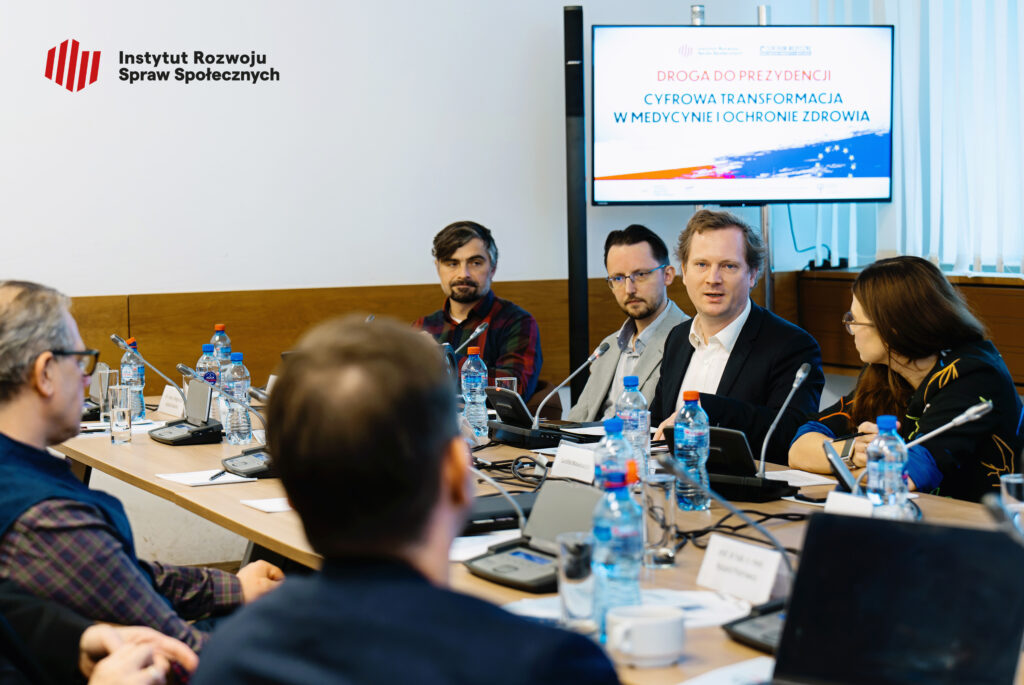News
backPolish Recipe for e-Health: What Solutions Will We Propose to Europe During the Presidency?
The digital revolution in medicine is becoming a reality, but is Poland ready to lead this change in Europe? This question dominated discussions among experts during the conference “Path to the Presidency: Digital Transformation in Medicine and Healthcare”, organized by the Institute for Social Development (IRSS) and the Medical University of Warsaw’s Medical Center. On the one hand, e-prescriptions, telemedicine, and the Internet Patient Account position Poland at the forefront of digital transformation. On the other, challenges such as the European Health Data Space (EHDS), lack of full system interoperability, and the risk of digital exclusion for the elderly require immediate attention. Will Poland’s EU Council Presidency be a springboard to build a modern, universally accessible healthcare system, or will it “drown” in a sea of data without real benefits for patients?

Małgorzata Bogusz, President of the Institute for Social Development and Member of the European Economic and Social Committee, emphasized that the presidency does not involve ongoing legislative processes. However, during Poland’s leadership of the EU Council, digitalization will be a key focus area.
- “During our presidency, the European Health Data Space (EHDS) project, the most significant document addressing digitalization in healthcare, will be discussed and finalized,” said Bogusz.
Marta Musidłowska from the Catholic University of Leuven also addressed the EHDS. Despite two years passing since the EHDS draft was published, two contrasting perspectives persist.

- “One predicts improvements in all areas of healthcare, especially regarding faster and better access to electronic health data for public authorities and enhanced data availability for research and innovation, including AI development. Patients, as the primary beneficiaries, would gain from new technologies, access to medicines, and the overall digitalization of medicine,” Musidłowska highlighted.
She also noted concerns about trust in legislative processes and public authorities handling data sharing. - “EHDS is a transnational project introducing significant changes in member states’ healthcare systems. Doctors fear additional administrative burdens related to mandatory data registration. Private companies worry about market position, data access requirements, and protecting trade secrets. Patients are concerned about potential exposure of sensitive personal health and life data,” she added. Musidłowska stressed the importance of constructive discussions on preparing for EHDS to maximize its benefits at both EU and national levels.
Experts at the debate agreed that Poland, during its EU Council Presidency, could share its experiences in healthcare digitalization.
- “Poland ranks fifth in the EU in terms of digital maturity of our solutions, including the Internet Patient Account (IKP), e-prescriptions, e-orders, and electronic medical records. According to the Center for e-Health, about 80% of healthcare providers in Poland have implemented electronic medical records either fully or partially,” noted Dr. Paweł Kaźmierczyk, Leader of the Medical Data Working Group at NIL IN.

Prof. Ryszard Piotrowicz of the Polish Academy of Sciences and the Polish Cardiology Society emphasized Poland’s unique telemedicine solutions.

- “Heart failure affects 12 million people in Europe, including about 1.5 million in Poland. It’s the most common and costly cause of hospitalization, with five-year survival rates lower than for severe cancers like lung cancer. Only a small percentage of European patients access cardiac rehabilitation. Poland pioneered hybrid rehabilitation funded by the state, allowing patients to rehabilitate from anywhere worldwide. This model of telemedicine can be showcased across Europe,” he stated.
Dr. Małgorzata Gałązka-Sobotka, Dean of the Postgraduate Education Center at Lazarski University, pointed out areas in Poland’s healthcare digitalization that still need improvement.
- “The biggest concern is the lack of internal system interoperability and data gaps. For example, the national HPV vaccination program dashboard is updated weekly and provides vaccination numbers, but it doesn’t account for privately vaccinated children or those vaccinated through local government programs,” she explained.
Dr. Piotr Samel-Kowalik from the Medical University of Warsaw highlighted the importance of current data for decision-making.
- “Outdated data in a rapidly changing world leads to flawed decisions,” he warned.
Paweł Łangowski, Chair of the SGI Europe Healthcare Committee, addressed challenges in medical data reporting.
- “Revolutionary EHDS solutions won’t materialize without comprehensive data. Hospitals report to the e-health system (P1), but primary care facilities often don’t. Without solving this, discussions on EHDS are secondary,” he emphasized.

Dr. Tomasz Imiela of the Warsaw Medical Chamber stressed that healthcare digitalization should not limit access to medical services.
- “If services become dependent on digital tools, some patients could lose access to care. Patient organizations must be involved in regulatory work to ensure inclusivity,” he noted.
Justyna Mieszalska, President of the Medical University of Warsaw’s Medical Center, raised concerns about digital tool accessibility.
- “Older adults, especially those over 65, often cannot fully benefit from projects like the Internet Patient Account (IKP). According to the 2016–2020 PolSenior study, only 20% of people over 80 are willing to learn how to use computers and smartphones,” she stated.






#EU2025Presidency #EUCouncil #DigitalTransformation #PublicHealth #EuropeanUnion #Healthcare #Poland
